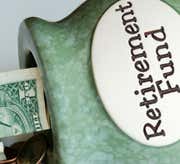While it's not difficult to understand that building a sufficient retirement fund takes more than a few years' worth of contributions, there are some substantial benefits to starting your retirement savings plan early.
The Early Bird Gets … the Nest Egg
One of the most important determinants of how large your nest egg can get is how long you let your savings grow. The reason for this is that the effects of compounding can become very powerful over long periods of time, potentially making the duration of your retirement savings plan a much more critical factor than even the size of your monthly contributions. (For more insight, see Understanding the Time Value of Money.)
The bottom line is, if you don't start saving for retirement early on in your working life, it will be more costly trying to play catch-up later on. It's much easier to put aside a small amount of money each month starting from a young age than it is to put aside a large amount of money each month when you are older. Unless you have other serious financial pressures, such as a lot of credit card debt, you should seriously consider starting to save for your retirement as early as possible.
For example, consider the hypothetical case of Earl and Lance, two 24-year-olds. Earl makes $1,000 annual savings contributions for 10 years and then never makes another contribution ever again. Lance makes no contributions during those 10 years, but then makes $3,000 annual contributions for the next 20 years. Assuming a 15% constant growth rate for both investors, who comes out ahead?
The answer, somewhat surprisingly, is that even though Lance contributed three times as much each year for twice as long, he ends up with the smaller nest egg because he started late!
The table below tracks their progress, starting at the end of their first working year:
 |
In fact, even if Lance keeps paying $3,000 annually (while Earl contributes nothing) until the end of time, he will never catch up to Earl, provided they both earn the same 15% annual growth rate. As you can see, it really does pay to start your retirement savings early.
It sounds counterintuitive, but even if you're paying off a student loan, you should still find a way to start saving for retirement as early as possible. Should I Pay Off Student Loans or Save for Retirement? explains why.
Compounding Your Tax Savings
The power of compounding works with taxes, too. As we mentioned earlier, it's important that you use government-sponsored investment accounts (such as IRAs) as much as possible while carrying out your retirement plan, since they will usually afford tax-deferred benefits.
What may surprise you, however, is how substantial the effects of deferring taxes can be over the long term. Again assuming an annual 15% growth rate on investments and 20% tax on capital gains and investment income, the chart below details just how much value there is in deferring your taxes for as long as possible.
Consider two investments of $1,000 invested for 30 years, one in a tax-deferred account and the other in a taxable account. Assume that taxes are paid each year on all capital gains in the taxable account. The end result after 30 years is that taxes leave the taxable investment's size at about half that of the tax-deferred account.
 |
Of course, this graph is based on the assumption that the taxable investment account turns over its portfolio each and every year (i.e., 20% capital gains tax rate is applied to all capital gains each year). If the taxable portfolio held on to stocks for the long term, for example, the capital gains taxes would be delayed.
Regardless, it is usually not beneficial to incur taxes sooner, as opposed to later, and this example should make it clear that failing to take advantage of the tax-sheltering options available could be very costly.
The Bottom Line
Begin saving for retirement as early as possible and take full advantage of whatever tax-sheltering opportunities are available for as long as you can.
Retirement Planning: Asset Allocation and Diversification
-
 Retirement
RetirementIntroduction: Protecting Your Nest Egg
Protecting your nest egg involves maximizing savings and minimizing taxes. For the following 12 weeks, we will explain the best ways to do both. -
 Retirement
RetirementTop 4 Reasons To Save For Retirement Now
Learn how to make sure you are financially secure and independent for your golden years. -
 Retirement
RetirementSaving $100 Now Is Better Than Saving $1,000 In 10 Years
Learn why it is better to save $100 every year starting right now rather than $1,000 in 10 years, and find out the benefits of early saving and investing. -
 Retirement
RetirementSaving for Retirement: The Quest for Success
We'll show you how to set yourself up to retire in style. -
 Retirement
RetirementRetirement Savings: Keep Your Eyes on the Prize
Setting retirement savings goals by decade helps you get on track and stay there. -
 Financial Advisor
Financial Advisor8 Essential Tips for Retirement Saving
Whether you're a saver or a financial advisor who wants to give clients a leg up, these 8 tips are essential for financial planning. -
 Retirement
RetirementWill Your Retirement Income Be Enough?
How to figure if you'll have enough for those golden years – and what factors to consider in crunching the numbers.



